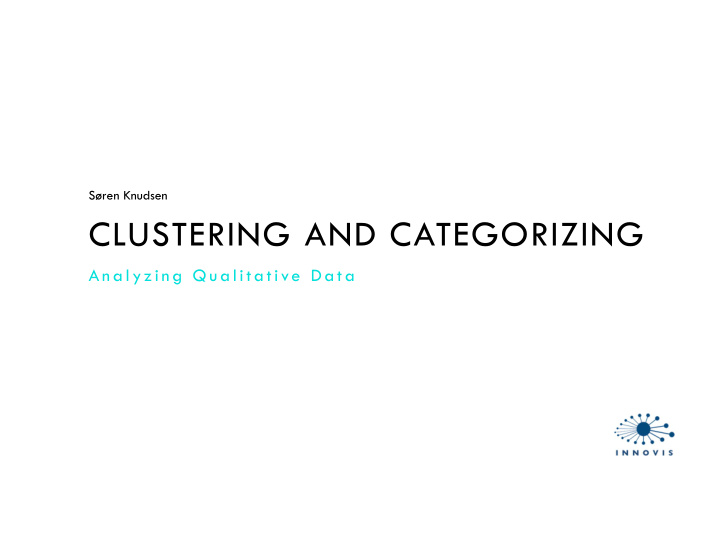



Søren Knudsen CLUSTERING AND CATEGORIZING A n a l y z i n g Q u a l i t a t i ve D a t a
CODE DEVELOPMENT CODING SORTING SYTHESIZING THEORIZING Codes Categories Themes Theory Specific Abstract / General - adapted from Saldaña, 2013
CODE DEVELOPMENT CODING SORTING SYTHESIZING THEORIZING Codes Categories Themes Theory Specific Abstract / General • Categorize codes Focused coding • and build themes Axial coding • from: Theoretical coding • • The relationship Pattern coding • between codes Elaborative coding • • The common Longitudinal meaning coding between codes - adapted from Saldaña, 2013
Aim To be able to say something meaningful on a topic To understand what you still know little about To describe in a paper, thesis, presentation, …
Distilling the richness of the data, Focus, Relating concepts, ...
Make sense of the coded data Clustering Categorizing Relating codes around a core focus
Example study: Data analysts imagine collaborative analysis on large displays
Wo r k s h o p s t u d y o n l a r g e d i s p l a y s a n d v i z Artistic photography Knudsen et al., 2012
Excerpt of codes from this study Compare two groups [of data] Novel Compare many groups representation Working with, representing and understanding Persistency groups or segments in data Working with multiple different Representations of data representations of data simultaneously Known representation Confusing Bubble plots Knudsen et al., 2012
Excerpt of codes from this study Compare two groups [of data] Novel Compare many groups representation Working with, representing and understanding Persistency groups or segments in data Working with multiple different Representations of data representations of data simultaneously Known representation Bubble plots Knudsen et al., 2012
Excerpt of codes from this study Compare two groups [of data] Novel Compare many groups representation Working with, representing and Persistency understanding groups or segments in data Working with multiple different Representations of data representations of data simultaneously Known representation Bubble plots Knudsen et al., 2012
Excerpt of codes from this study COMPARE GROUPS OF DATA Compare two groups [of data] Novel Compare many groups representation Working with, representing and Persistency understanding groups or segments in data Working with multiple different Representations of data representations of data simultaneously Known representation Bubble plots Knudsen et al., 2012
Excerpt of codes from this study COMPARE GROUPS OF DATA Compare two groups [of data] Compare many groups Working with, representing and understanding groups or segments in data Working with multiple different representations of data simultaneously Knudsen et al., 2012
Excerpt of codes from this study COMPARE GROUPS OF DATA Compare two groups [of data] Working with, representing and understanding groups or segments in data Working with multiple different representations of data simultaneously Compare many groups Knudsen et al., 2012
Excerpt of codes from this study COMPARE GROUPS OF DATA Working with, representing and understanding groups or segments in data Working with multiple different representations of data simultaneously Compare two groups [of data] ? Compare many groups Knudsen et al., 2012
“The purpose of axial coding is to begin the process of reassembling data that were fractured during open coding” Strauss & Corbin, 1998
Empirical data can have many forms
Can be Auditory Textual (e.g., interview transcripts, web-material, papers) Visual (e.g., photos, videos, drawings) Artifacts
Process and approach Computer Assisted Qualitative Data Analysis Systems (CAQDAS) MaxQDA nVivo Saturate app Based on pen-and-paper Based on a large surface (e.g., whiteboard, table, floor)
EXERCISE: CLUSTERING DATA Analyzing Qualitative Data
VISUAL DATA Collection of postcards by G. Lupi and S. Posavec from the “Dear Data” Project
PROCESS 1. Familiarize yourself with the data set spread out the postcards look at them individually 2. Group them in clusters find postcards that you think share a commonality group these postcards spatially create a label for these groups 3. Look for potential spectrum based on the groups, consider spectrums/axes in the data
EXTRA INFORMATION
List of CAQDAS’s ATLAS.ti: www.atlasti.com HyperRESEARCH: www.researchware.com MAXQDA: www.maxqda.com NVivo: www.qsrinternational.com QDA Miner: www.provalisresearch.com Qualrus: www.qualrus.com Transana: www.transana.org (for audio and video data materials) Weft QDA: www.pressure.to/qda/ Noldus Observer: http://www.noldus.com/human-behavior-research/products/ Saturate app: http://www.saturateapp.com/
Recommend
More recommend